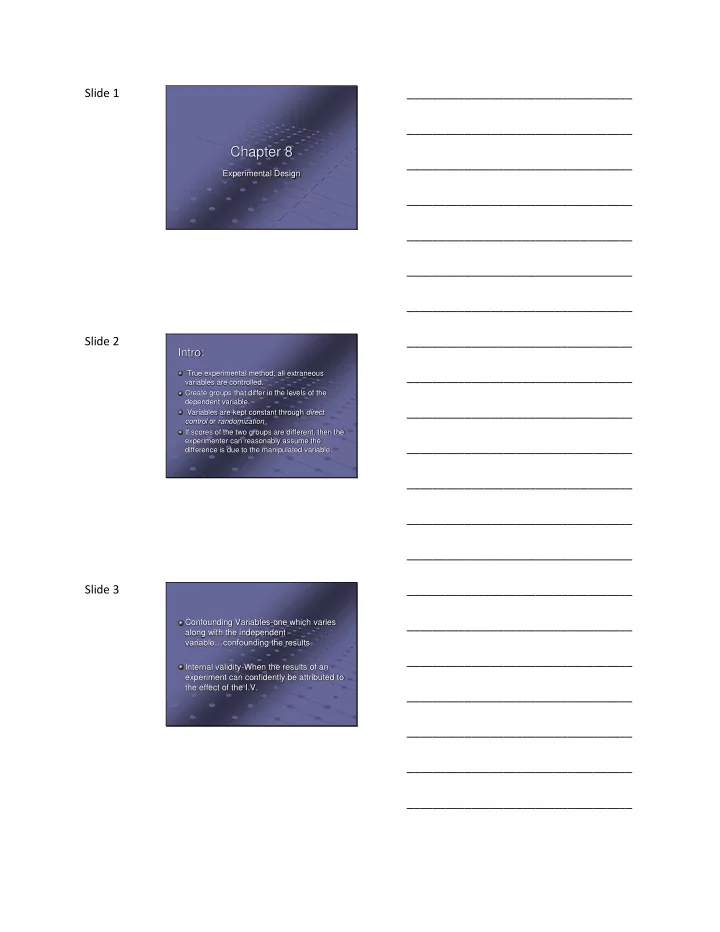

Slide 1 ___________________________________ ___________________________________ Chapter 8 ___________________________________ Experimental Design ___________________________________ ___________________________________ ___________________________________ ___________________________________ Slide 2 ___________________________________ Intro: True experimental method, all extraneous ___________________________________ variables are controlled. Create groups that differ in the levels of the dependent variable. ___________________________________ Variables are kept constant through direct control or randomization If scores of the two groups are different, then the experimenter can reasonably assume the ___________________________________ difference is due to the manipulated variable. ___________________________________ ___________________________________ ___________________________________ Slide 3 ___________________________________ Confounding Variables-one which varies ___________________________________ along with the independent variable…confounding the results. ___________________________________ Internal validity-When the results of an experiment can confidently be attributed to the effect of the I.V. ___________________________________ ___________________________________ ___________________________________ ___________________________________
Slide 4 ___________________________________ Basic Experiments Post-test only ___________________________________ Pre-test/Post-test Design Independent Groups Design ___________________________________ Repeated Measures Design ___________________________________ ___________________________________ ___________________________________ ___________________________________ Slide 5 ___________________________________ Post-test Only Participants are assigned to at least two groups, ___________________________________ experiment and control the effect is measured once. Levels of independent variable are chosen: two levels at least treatment and control, or two levels of ___________________________________ treatment — can have more than one level. Advantage: easy & inexpensive Disadvantage: Does not always assure groups were ___________________________________ truly equivalent (experimental & control) ___________________________________ ___________________________________ ___________________________________ Slide 6 ___________________________________ Pretest/Posttest a pre-test is given before the manipulation is ___________________________________ introduced. A pre-test can assess whether the groups were equivalent prior to the manipulation.. Pre-test allows the measurement of the extent of ___________________________________ change in the group or an individual participant. Advantage: Can assess equivalence, mortality and extent of change. Disadvantage: Time consuming and awkward., can sensitize the participants to what you are ___________________________________ looking for and they may act differently. ___________________________________ ___________________________________ ___________________________________
Slide 7 ___________________________________ Solomon’s Four Group Design ability to directly assess the impact of the ___________________________________ pretest with a combination of both the posttest-only and the pretest-posttest design. ___________________________________ Half of the participants receive only the posttest and the other half receive both the pre and post test. If there is on impact of the pretest, both of the ___________________________________ posttest scores will be the same. ___________________________________ ___________________________________ ___________________________________ Slide 8 ___________________________________ Independent Groups Design Different participants are assigned to each ___________________________________ of the condition using random assignment. Decision to assign an individual to a ___________________________________ particular condition is completely random and beyond the control of the researcher. ___________________________________ ___________________________________ ___________________________________ ___________________________________ Slide 9 ___________________________________ Repeated Measures Alternative to the independent groups ___________________________________ design the same individual participants are in all of the groups. Advantage s: ___________________________________ Fewer research participants needed as each participant serves in all conditions. Extremely sensitive to finding statistical significant differences Reduces random error due to individual differences as ___________________________________ there is data from the same people in both conditions ___________________________________ ___________________________________ ___________________________________
Slide 10 ___________________________________ Repeated Measures Disadvantages: ___________________________________ Order effects- different conditions must be presented in a particular sequence which can cause two types of problems Practice effects- an improvement in performance ___________________________________ as a result of repeated practice. Fatigue effects- a deterioration in performance as the research participant becomes tired, bored or distracted. ___________________________________ Carry-over effects- effect of the first treatment carries over to influence the response to the second treatment. ___________________________________ ___________________________________ ___________________________________ Slide 11 ___________________________________ Approaches to Order Effects Counterbalancing- all possible orders of ___________________________________ presentation are included in the experiment . Latin square- is a limited set of orders constructed to insure that each condition appears at each ordinal position, and that each ___________________________________ condition precedes and follow each condition one time. Randomized Blocks- basic experimental procedure is repeated many times. ___________________________________ Time Interval Between Treatments ___________________________________ ___________________________________ ___________________________________ Slide 12 ___________________________________ Other Research Designs Matched Pairs Design ___________________________________ Developmental Research Designs Cross Sectional Method Longitudinal Method ___________________________________ ___________________________________ ___________________________________ ___________________________________ ___________________________________
Recommend
More recommend